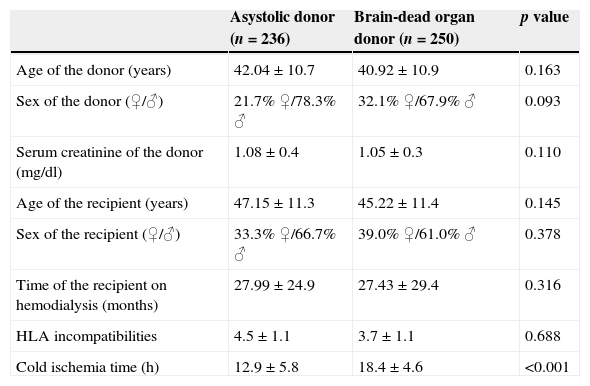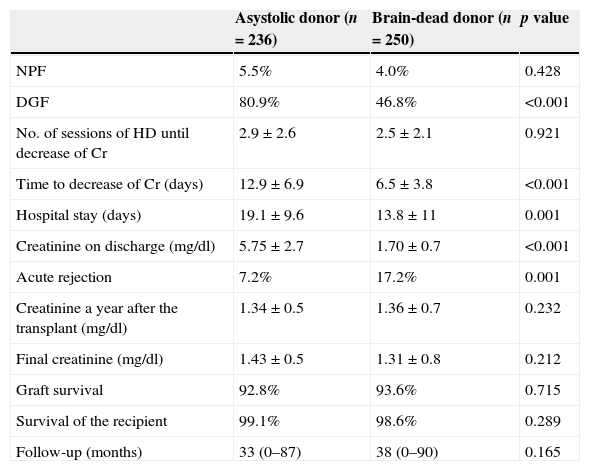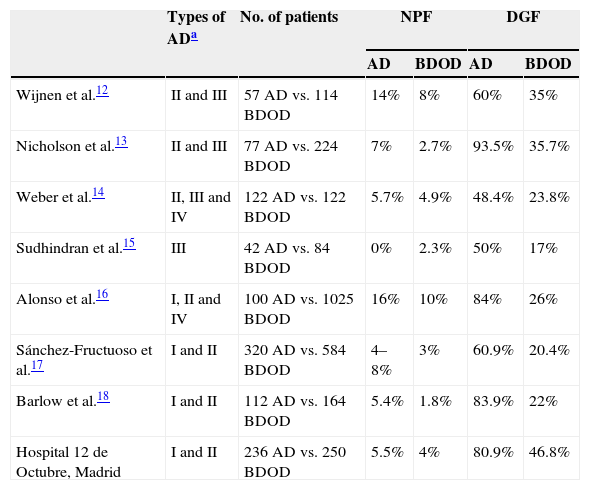Non-heartbeating donors (NHBD) are an alternative to heartbeating donors (HBD). Our objective was to compare functional results and kidney survival from NHBDs and HBDs.
Material and methodsA retrospective study comparing the results of 236 normothermically preserved kidneys from type I and type II NHBDs with the results of 250 from HBDs that were transplanted in our center between 2005 and 2012. Homogeneity between groups was tested and we evaluated the presence of delayed graft function (DGF) associated with pretransplant variables of the donor and recipient.
ResultsBoth groups show homogeneity in pretransplant characteristics in terms of: age, HLA incompatibilities, and recipient hemodialysis time. Average follow-up time was 33 months (range 0–87) for NHBDs and 38 months (range 0–90) for HBDs. 5.5% of NHBDs showed primary non-function (PNF) vs. 4% of HBDs (p=0.42) and 80.9% of DGF vs. 46.8% of HBDs (p<0.001). At the end of the follow-up, there were no statistically significant differences in the survival of grafts (92.8% for NHBD vs. 93.6% for HBD, p=0.71) and recipients (99.1% NHBD vs. 98.6% HBD, p=0.28).
ConclusionsAlthough the DGF percentage was greater for NHBDs, final creatinine as well as graft and recipient survival were similar for both groups. Therefore, in our experience, kidneys from NHBDs have similar results to those from HBDs and are an excellent source of organs for transplantation.
El donante en asistolia (DA) es una alternativa al donante en muerte cerebral (DMC). Nuestro objetivo es comparar los resultados funcionales y la supervivencia de riñones procedentes de DA y DMC.
Material y métodosRealizamos un estudio retrospectivo comparando los resultados de 236 riñones de DA tipos I y II preservados en normotermia con 250 procedentes de DMC, trasplantados en nuestro centro entre 2005 y 2012. Se comprueba la homogeneidad entre grupos y evaluamos si la presencia de retraso en la función del injerto (RFI) de asocia a las variables pretrasplante de donante y receptor.
ResultadosAmbos grupos muestran homogeneidad en las características pretrasplante en cuanto a: edad, incompatibilidades HLA, tiempo del receptor en hemodiálisis. El tiempo medio de seguimiento es de 33 meses (rango 0–87) los DA y 38 meses (rango 0-90) para DMC. Los DA mostraron un 5,5% de no función primaria (NFP) frente a un 4% en los DMC (p=0,42) y un 80,9% de RFI frente a un 46,8% de los DMC (p<0,001). Al final del seguimiento, no hubo diferencias estadísticamente significativas en la supervivencia del injerto (92,8% DA vs. 93,6% DMC, p=0,71) y receptores (99,1% DA vs. 98,6% DMC, p=0,28).
ConclusionesAunque el porcentaje de RFI es mayor para los DA, tanto la creatinina final como la supervivencia del injerto y el receptor son similares para ambos grupos. Por tanto, en nuestra experiencia los riñones procedentes de DA tienen resultados similares a aquellos de DMC y constituyen una excelente fuente de órganos para trasplante.










